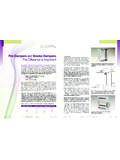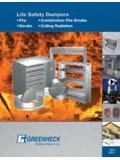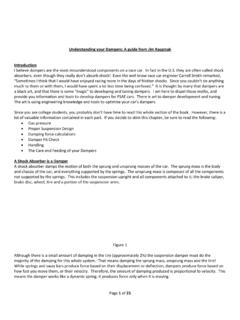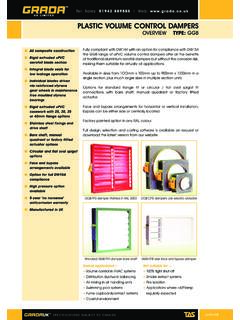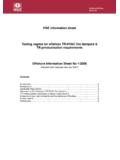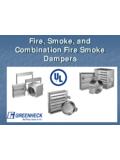Transcription of Smoke & Fire Dampers
1 1 Smoke & fire DampersLarge public and commercial buildings generally use Air Handling Units (AHU s) to circulate fresh conditioned air throughout the building via various ductwork sections. Wherever the ductwork penetrates a fire barrier, a fire or a Smoke / fire damper must be installed. Depending on the size and layout of the building several AHU s may be required. For very large buildings you could have up to 20 off AHU s and 1000 s off fire and/or Smoke / fire Dampers . fire dampersKnown as curtain type Dampers . Constructed as a series of interlocking blades, which fold to the top of the assembly against coiled springs on either side of the blade pack, permitting the maximum free area in the airway. The blades are held in the open position by means of a thermal release mechanism rated at 72 C +/- 4 .The fire damper must be able to close against dynamic air conditions in either the vertical or horizontal dampersMulti-bladed construction, blades rotate to the open or closed position via mechanical linkages and seal against the damper case and blade to blade.
2 The blades are mechanically connected to an electric actuator and are triggered by interfacing with a Smoke detector or a Safegard System. In future, these types of Dampers will use drive open/closed actuators as power is assumed to be available throughout the Smoke damper must be able to close against dynamic air conditions in either the vertical or horizontal present there is no legislation or test criterion covering these types of Dampers as it is currently being debated in EU committees expected in 2011. The relevant standard will be EN Dampers Multi-bladed construction, blades rotate to the open position via mechanical linkages and seal against the damper case and blade to blade. The blades are mechanically connected to an electric actuator to provide opening and fail safe spring loaded closing. The blades are held in the open position by means of a thermal release mechanism rated at 72 C +/- 4.
3 These types of Dampers use fail-safe actuators and are normally triggered by heat / Smoke detector or a Safegard Control & Monitoring System. The Smoke / fire damper must be able to close against dynamic air conditions in either the vertical or horizontal planes. Should these Dampers be used to fail-safe open then they do not need to be fire rated Dampers , however, they are often misused or operating temperature Smoke and fire dampersMulti-bladed construction, blades rotate to the open position via mechanical linkages and seal against the damper case and blade to blade. The blades are mechanically connected to a damper actuator with electric opening and fail safe spring loaded closing or electric closing and spring loaded opening. In future, these types of Dampers will use drive open/closed actuators as power is assumed to be available throughout the incident.
4 The actuator is encased in a thermal enclosure normally rated up to 300 C for 1 hour. These types of Dampers use fail-safe actuators with no fusible links and are triggered by interfacing with a heat/ Smoke detector or a Safegard Control & Monitoring System. The Smoke and fire damper must be able to close against dynamic air conditions in either the vertical or horizontal present there is no legislation or test criterion covering these types of Dampers as it is currently being debated in EU SAFEgArD SySTEMS DAMpEr gUIDE rEv 3, OCT 2010 (IrElAND & UK)2 The 1997 Building regulations are the law. part B deals with fire Safety and makes statements like A building shall be so designed and constructed that the unseen spread of fire and Smoke within concealed spaces in its structure or fabric is inhibited where necessary Our Building regulations and Technical guidance Documents do little to advise when and where fire and Smoke / fire Dampers should be , we have to look to the UK Approved Documents, British Standards, HvCA specifications and the loss prevention Council (lpC) for some guidance.
5 The pertinent editions are as follows: Approved Document B - April 2007 BS9999 - Code of practice for fire Safety. Supersedes previous publications (BS5588) since 6th April 2009. Health Technical Memorandum 03-01 - November 2007 HvCA DW145 - Industry guide for the installation of fire and Smoke / fire Dampers (not Smoke Dampers ). Supersedes previous publication (DW144) since 13th May 2010. lpC design guide for the fire protection of buildingsUnfortunately, all of these published documents offer guidance, however, fire engineering input is generally the latest revision of Approved Doc B was released, the only legislation that was in force to cover how fire and Smoke / fire Dampers were tested was BS476 part 20 1987, as follows:- 1000 x 1000mm damper c/w hevac frame mounted vertically in a furnace wall. The damper is closed and then the furnace is lit.
6 Provided the damper maintains its integrity (see rod test) for 2 hours then it has passed the test. rod test = 6mm rod may be able to be inserted through blades provided the gap is no larger that 150mm long in length in any direction. Also, a 25mm rod is used and must not be able to be passed through the blades at any point. This adhoc standard is not specific to Dampers and is useless as it does not cover how they are normally installed, how they operate and how much they leak, which is obviously critical to Smoke are now European standards EN1366-2 which Dampers must meet; however, our legislation still allows the BS standard as above for certain installations until July EN standard is joined by the International standard ISO10294-1, which is basically the same as EN except it follows a slightly different time/temperature curve.
7 BS have now adopted both these standards, but as mentioned above the old BS standard is still acceptable for certain installations. please refer to the last page of this document which is an extract from Approved Doc B. These latest standards embody much more rigorous test conditions including: reliability, leakage and symmetry, as follows:- fire test = largest single module damper (can be > 1000 x 1000mm) c/w hevac frame mounted vertically in a furnace wall. Test repeated with largest single module damper c/w hevac frame mounted horizontally in the furnace floor. fire resistance E, (classed E) = largest single module damper fire tested for 120 or 240 minutes with a maximum permissible leakage of 100 l/s @ 300pa corrected back to 20 C. leakage S, (classed ES) = largest & smallest single module damper to be leakage tested at ambient with a maximum permissible leakage of 55l/s.
8 Also, largest single module damper fire tested for 120 or 240 minutes with a maximum permissible leakage of 55l/s @ 300pa corrected back to 20 only concern with the EN standard is that for Smoke / fire Dampers it still relies on heat the fusible link must trigger the damper within two minutes of the furnace being lit. Safegard Systems lobbied for Smoke / fire Dampers to be activated by Smoke detectors only, but to no 2005, the Building research Establishment (BrE) took five fire Dampers from five separate UK manufacturers and tested them in a normal ducted environment with various Kw rated fires and fans running and then fans off. One of the most startling results was that with a 500Kw fire burning under the nearest vent to where the fire damper was mounted and with no fan running none of the fire Dampers had closed after 20 minutes!
9 Worryingly, Approved Doc B states that fire Dampers tested using ad-hoc procedures based on BS476 may only be appropriate for fan-off situations . Obviously, the BrE have not made their findings open to the UK a result of the BrE tests and to promote good practice, Safegard Systems recommendation is to use Smoke / fire Dampers actuated by Smoke and controlled by a Safegard Control & Monitoring System or other appropriately designed system. This recommendation is also endorsed by the lpC design guide and is one of the changes in the Approved Document B - April 2007 Where the use of the building involves a sleeping risk, such as an hotel or residential care home, fire Dampers should be actuated by Smoke detector-controlled automatic release mechanisms, in addition to being actuated by thermally actuated devices.
10 BS9999 states that thermally operated fire Dampers should not be used to protect escape routes nor in Smoke control systems. Also, Smoke detector operated fire / Smoke Dampers should be in all occupancy characteristic Cii and Ciii buildings, unless all occupants of the building can be expected to make an unaided pertinent point that designers must consider is occupants familiarity with their surroundings. In airports, hospitals, hotels etc it is extremely easy to become disorientated especially in an emergency situation. For this reason, hospitals in the UK are also covered by specific Health Technical Memorandum (HTM) and it should be noted that last year the Scottish HTM stipulated that only Smoke / fire Dampers would be allowed in all future hospital SAFEgArD SySTEMS DAMpEr gUIDE rEv 3, OCT 2010 (IrElAND & UK) FurTher InFormaTIon ConTaCT SaFegard SySTemSSystems House, Unit 34, Southern Cross Business Park, Bray, Co.

